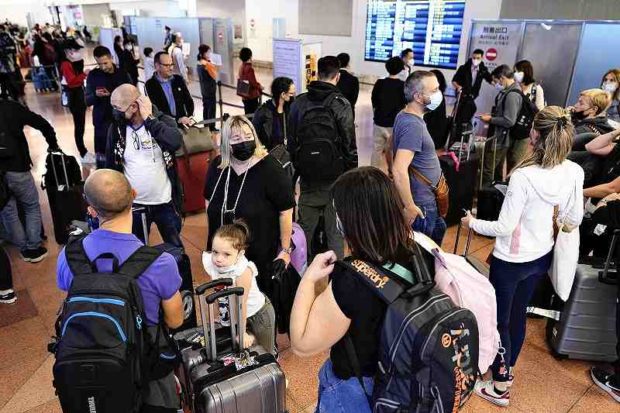
Arrival gates for international flights are crowded with tourists on Tuesday at Tokyo’s Haneda Airport. The Japan News/Asia News Network
TOKYO — Japan’s border control measures were greatly eased on Tuesday, including the elimination of the ban on individual tourists from abroad.
Haneda Airport in Tokyo and Narita Airport in Chiba Prefecture were crowded with foreign tourists on the day, perhaps drawn partly by the yen’s recent plunge against the dollar. A Japanese government-sponsored program to stimulate domestic tourism demand has also begun, raising hopes in the tourism industry, which has been hit hard by the COVID-19 pandemic.
A 54-year-old German woman arrived at Haneda Airport with a friend on Tuesday morning. “Finally, my dream has come true,” said the woman, who admires Japanese culture and scenery. She and her friend planned to stay for two weeks.
“We’re going to enjoy hot springs in Hakone [in Kanagawa Prefecture], and are looking forward to experiencing traditional Japanese culture tomorrow in Osaka and Kyoto,” she said.
A 42-year-old engineer from Australia arrived at the airport with his partner, on a trip to visit the partner’s parents in Tokyo. The man said he can finally introduce himself in person, thanks to the lifting of the individual travel ban.
The entry cap of 50,000 people a day to Japan has been abolished. Likewise, coronavirus testing upon entry is no longer required if a traveler presents proof of having received three vaccinations or a negative coronavirus test taken prior to departure.
Visas are waived for short-term stays for tourists from 68 countries and regions, including the United States and South Korea.
Since February 2020, when the government denied entry to non-Japanese who had been in China’s Hubei Province where coronavirus infections were spreading, the government had imposed various limits on entry. As of Tuesday, however, border control measures had almost returned to pre-pandemic levels.
The number of foreign visitors to Japan, which was about 31.88 million in 2019, plummeted to about 240,000 last year.
However, after the announcement of the planned easing of the border control measures in September, bookings on international flights bound for Japan surged, with All Nippon Airways seeing a five-fold increase over the period from December to January next year compared to before the announcement.
Japan Airlines also saw a more than threefold increase over the period from November to December. “The weak yen is providing a tailwind,” a JAL official said.
The government-sponsored program to stimulate domestic tourism demand subsidizes 40% of travel expenses for public transportation and accommodations. Together with coupons that can be used for eating out and purchases at a traveler’s destination, the maximum subsidy amount is ¥11,000 per person per day. The program will be implemented in Tokyo from Oct. 20.
Another government-sponsored subsidy program that offers a 20% discount (up to ¥2,000) on the price of tickets to movies, sports games and other entertainments likewise began Tuesday.
Prime Minister Fumio Kishida on Sunday expressed his hopes for the subsidy programs and the easing of border control measures after watching the Japanese Grand Prix of the Formula One World Championship at Suzuka Circuit in Mie Prefecture.
“We want many people to enjoy events across the nation and hope it will invigorate Japan,” Kishida said.
RELATED STORIES
Japan reopens to tourists with shuttered souvenir shops, hotel staff shortage
Daily cap on entry to Japan, ban on individual tourists to be scrapped from Tuesday